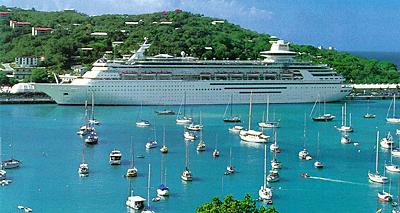
 |
| Home |
| |
|
The cruise industry brought in more
than $60 billion last year and, up until September 11, 2001, has been
increasing at a rate of 7 percent per year for the past twenty years.
Post September 11, the travel industry suffered setbacks and two cruise
lines, Renaissance and American Classic Voyages, filed for bankruptcy.
However, this reduced the available seating capacity for cruises by 3.5
percent, and the major cruise lines have picked up the slack; as early
as November, 2001, Carnival, Royal Caribbean and Princess Cruises reported
some recovery in bookings. Today, the surviving cruise lines are stronger
than ever before. |
|
So who is profiting from the cruise industry?
Some American ports are profiting too. Among these, Miami is the most successful. In 1997, 24 percent of the world's cruise passengers left from the Port of Miami. The way cities profit from the cruise industry is by getting passengers to stay on at local hotels, spending money at local restaurants and shops. 68 percent of Miami cruise tourists stayed in the city for an average of two days, and added a record of $447 million to the local economy in 1997. Other ports that enjoy profits from the cruise industry include Fort Lauderdale's Port Everglades, and Port Canaveral. |
|
Cruise lines have been able to avoid sharing their
money with the United States government and Caribbean governments as well.
Many cruise lines register their ships in Liberia to avoid following American
and Caribbean regulations. They are able to "save boatloads on labor,"
said one cruise official. |
Cruise tourists pumped $447 million in to Miami's local economy in 1997. |
| The governments that are slighted most by the cruise
industry are in the Caribbean. Allen Chastanet, a former director of tourism
for St. Lucia, said, "Sixty-five percent of the cruise industry's
profit comes from the Caribbean, but only 7 percent of their employees
come from the Caribbean, and only 1 percent of the taxes they pay go to
the region." Cruise lines who have complete control over their passengers
spending leaves Caribbean economies with few opportunities to benefit
from cruise tourism. |
|
In the meantime, Caribbean governments outspend their budgets trying to attract tourists. In 1999, St. Lucia spent $14 million on tourism promotion alone, and spent an additional $14 million on a cruise-terminal expansion. Cruise passengers are only charged a $6.50 per person tax, which in 1999 only added up to a measly $1.9 million for the St. Lucian government. And unlike Miami, many tourists do not choose to stay in the Caribbean on their own, further hurting their economies. |
 |
|
Cruise liners are so powerful that they can withstand almost any effort of opposition. In 1993, 13 Caribbean islands came together to demand the tax on cruise passengers be raised to $15 per person and the cruise lines fought back hard. John Bell, the executive vice president of the Caribbean Hotel Association describes the battle: "the cruise lines went one-to-one with the governments and said, 'If you impose the head tax, we will no longer come to your island.' Within a week, the islands started breaking ranks, and then they all fell apart." Back.
Sources: Ballestero, "Biz hits cruise control" Goetzel, David. “Cruising to Nowhere.” Advertising Age. Nov
12, 2001 vol 72 no 46, Reed, Tucker. “Why do Ships Register in Liberia?”Fortune.
June 11 2001. vol 143 no 12 Wise, Jeff. "How Cruise Ships Shortchange the Caribbean." Fortune. Mar 29 1999. vol 139 no 6, p. 44.
|